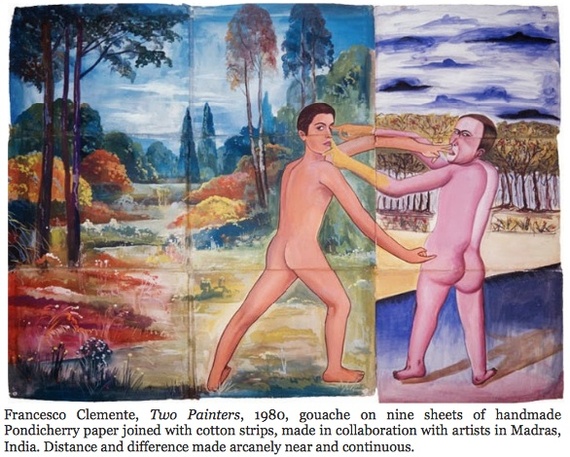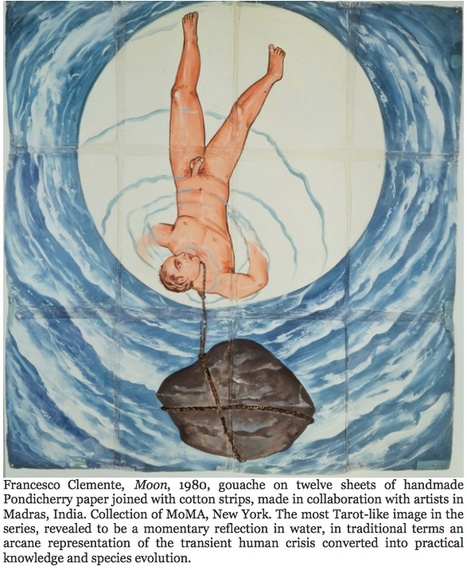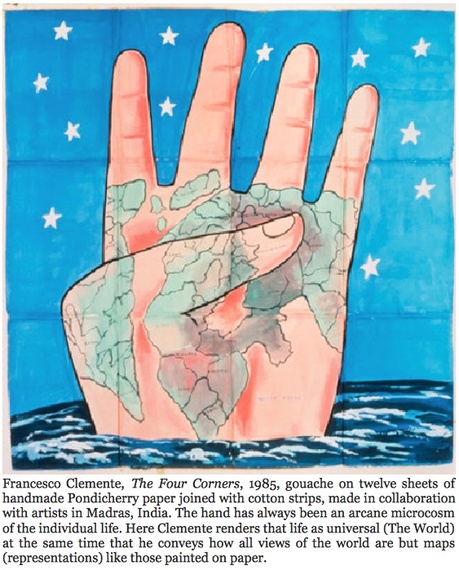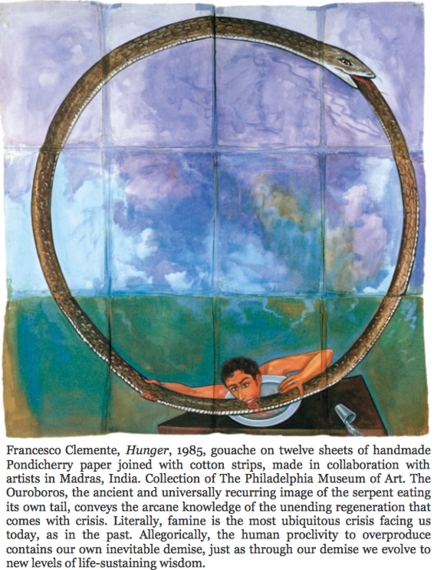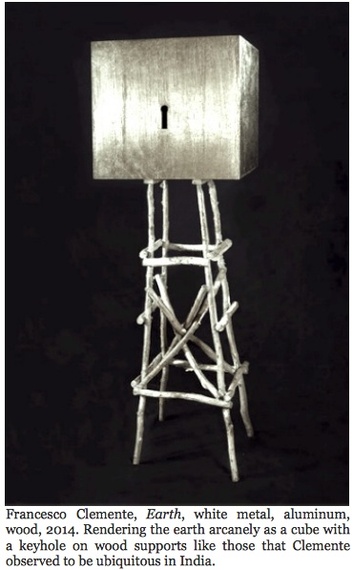Francesco Clemente has long had an affinity with the people, art and culture of India. A small but illuminating selection of his Indian-based work has been laid out in the plan of an Indian Temple at The Rubin Museum in New York and will be on display through February 2, 2015. For more information on the show and the museum, visit the Rubin Museum website.
Francesco Clement may be the only world class artist alive today able to turn the arcane imagery of old spectacularly to his advantage. Living in an age that has depreciated the arcane, we are more likely to be at first drawn to his work for its consummate mastery. Clemente is nothing if not the premiere watercolorist alive, and only after his virtuosity registers with some time do we shift our admiration to his ability to turn his mind virtually inside out for our inspection and delight. If and when the representation of the arcane registers on the viewing consciousness of most Western art audiences, it does so as an afterthought. That's how far we've come in the age of science and reason from the valuation of arcane imagery as a conduit of practical knowledge. The question is, have we lost anything valuable with our depreciation of the arcane image and meaning?
Historically, the arcane hasn't played a prominent part in Western high art for over a century, with the Symbolists in 1890s Europe being the last celebrated artistic movement to place credence in visualizing the purported wisdom (or conceit) of profound but secret mysteries known only to guided initiates. The Surrealists flirted with the iconography of the arcane, but only to reduce it to the media of the mind, the formal properties that the psychoanalytic profession had made of it, a protean language as potent in what it can tell us about ourselves as dreaming.
Today the only serious and respected inquiry into the arcane is confined to the rational disciplines of psychology, anthropology and the study of religions and superstition, where it is regarded as just another system of picturing and conceptualizing. Whereas it was for millennia exalted in being inveighed with awe-inspiring and political power restricted to secret societies of initiates, priests and oracles, the arcane, or what is left of it, is redefined as a vocabulary of the imagination as democratic (if now impolitic) as any other conceptual and pictorial system rooted in material existence.
When the arcane has appeared in recent art, it is on the whole celebrated only when utilized by artists who, like the late artists Sigmar Polke, James Lee Byers and Dennis Oppenheim, or living artists Matthew Barney, Mariko Mori and Marina Abramovic, parody the arcane as a metaphor for the artist today possessed of an alchemical (read ironic, formalist) or an historical curiosity predisposed to scavenging through all the now-defunct esoterica in the junkyard of historic culture. To such artists the arcane image or object is of value largely in realizing a search for the substance to be transubstantiated into the gold of the avant garde art-and-auction market. In our skeptical and ironic age, Francesco Clemente stands alone in the esteem he has gathered for his serious inquiries into the value that the arcane image still has for civilization--though we can see his mark on a new generation of artists, such as Shazia Sikander. His standing is reaffirmed by the modest yet vibrant show of work made in India over the course of several decades shown this fall at The Rubin Museum in Chelsea, where we can choose to see the arcane being modeled as a viable, if not desirable, aesthetic, however much it remains discredited as a vehicle of knowledge. Or does it?
Clemente doesn't promote himself as a conjurer of the arcane. There is no mention of it in the Rubin Museum's press package, despite that Clemente has designed the show in the architectual layout of an Indian temple. Neither does he pose as a mystic in his brief interview with the Italian critic, Ida Panicelli, in the September 2014 issue of Artforum. Rather, Clement speaks around the arcane when, describing his working process of "always returning to the ancient esoteric precept, 'As it is above, so it is below,' the vase is the body, the body is the vase, the wind is the flag, the flag is the wind." Such correspondences, really analogies, are at the very heart of the belief that the arcane can be known through a kind of interpretation of formal resemblances that informs what Foucault has called "the prose of the world"-- the ancient proclivity of reading ordinary objects, both natural and manufactured, as if they were inscribed with wisdom, or they themselves were inscriptions of the divine. It is the reading of objects that is to have informed the magi, priests and oracles of the power of creation. That is, until we came to read them scientifically for what empirical processes and systems were made apparent by and within them.
In his interview, Clemente himself dispels the baser conceit of the mystic prognosticator that always allowed the sham among the shamans to seize authority. "I have no interest in dogmatic icons; I have no pretense of imposing yet another dogma on the world. I simply would like to offer this observation: What we are taught to regard as experience is incomplete, and it is normal to have a vaster and more direct, more unmediated experience of ourselves and of the world. Almost everything presented to us is a convention, and I would like to produce images that avoid this."
If it is not easy to see in Clemente's Rubin Museum show a modern revaluation of the arcane, it is because the arcane has become misunderstood by thinking people today, associated only with the superstitious and denial of the inevitable crisis or demise. Stripped of its political exaltation of initiates and enrichment of charlatans, the arcane for populations without our vocabulary of psychology and sociology played a crucial role in enabling people to adapt to pain and crisis by helping them to channel both an individual and a collective mental focus onto converting turmoil and conflict into growth and evolution. Whatever the arcane's orientation to the real world, it was foremost the language by which a people void of empirical and demonstrated knowledge of facts emerged from loss and ruin with a renewed sense of what was called, and for many today is still called, the sacred in life. For the sacred is really no more than an enhanced sensitivity to the ways that nature enables survival against all odds. Through the symbiology of the arcane, the catastrophe was made into a test of strength and character at the same time that it was converted into a cathartic transformation, a rationale and ritual for letting go and changing. The entire world is made into a symbolic instruction as to why something dies so that something new can be born. Today we call this contextualization: the setting defines the thing, be it object, thought or action.
Bringing this back to Clemente, the context in which we view one of his paintings does condition our reception of it. In the early 1980s, I saw some of these paintings at the Sperone Westwater Gallery in Soho. At that time their arrival, along with the newly proclaimed epoch of postmodernism in which artists were reintroducing content to art, seemed like a reaction to a century of reductionism and formalism. In other words, they made Clemente seem like a bad boy, a rebel, a revitalizer of the avant-garde, if not a proponent of the avant-garde's demise. Today, at the Rubin Museum, Clemente seems more the sage modeling a Janus-like wisdom balancing admirations for the civilizations past and to come.
By this I mean that Clemente may be seen as an artist who revives not the arcane itself, but the forms and contents of various ages, cultures, even whole civilizations, as an interconnected visual system by which we learn how to develop and grow in the face of adversity, and thereby to understand how to use our most harrowing experiences creatively and significantly for the benefit of ourselves and others. This much is Clemente's hindsight. His foresight is to make imagery the product of a direct experience of the images seen with the mind's eye. Clemente calls this an unmediated experience, but here I must disagree, for the free associations of the mind aren't merely his art's content, they are also his medium. And to be a medium is to mediate, just as a direct experience can come to us only after it has already been made a well-circulated fact--that is, a concept that is recognizable as a concept. The point of this circular reasoning is to show that the old languages in which contradictions can be resolved by resorting to the blind but straight line of mysticism is no longer viable in an age dominated by reason, especially when reason demolishes the old "oppositions" by showing that things are not in nature linearly opposed, but merely circuitously different.
Seen within the setting of The Rubin Museum, with its collection of sacred Asian art, Clement's paintings and sculptures can be contextualized as posing contingencies--that is, possible resolutions to the world's contradictions with an art of informed spirituality. In another context--specifically for those viewers who prefer a more materialist metaphor--what is commonly called "spirituality" can be termed "informed personal enhancement." However one puts it, Clemente's art shows us that the art of the arcane is no more than a personal interiorization--that is, a self-meditating, self-understanding, self-healing procedure--that enables a more thoroughly democratic exteriorization--that is, the responsible integration of the priorities of the self with the effective manadates of the collective. This is another way of saying that we no longer need resort to an exalted class of priests and oracles (perhaps also politicians and talkin heads?) to interpret our roles, our solutions, in life. We can through our own exploration of the arcane within our lives conduct our own deliverance from pain and obstacles. The arcane in this light is redefined as the language (whether of images, symbols or terms) afforded by the mind that is within each person's capacity to understand and direct self-rejuvenation and constructive growth. It is a message that Clemente's art always signified, though never as saliently as within the Rubin Museum's inspiring context.
Only after understanding our own mental generation of a personal arcana can we understand how Clemente's 1980 series of paintings made in collaboration with artists in Madras are not merely evocative of an old-world image arcana that survives popularly in the Tarot, as some might seem. In fact, Clemente's "Moon," 1980, seems to conjoin the Tarot's major arcana of "The Moon" with "The Hanged Man" (or in some decks, "The Bound Man"), with his depiction of a Prometheus figure bound to a rock, yet seen not directly but in the rippled reflection of water. The reflection of a thing in water was often an arcane metaphor for that thing being, if not the unreality of a thing, certainly its transience--in the manner of the flux of all things alluded to as the flux of a stream by both Heraclitus and Siddhartha Gautama.
There are other reasons that the Tarot is summoned to mind when looking at certain of Clement's paintings--the emphasis on line, the vibrant colors. But these are the most superficial readings. Just as the reading of Clemente's 1989 erotic series, The Black Book, may by force of its contextualization at The Rubin be thought to be a rendering of the Kama Sutra, the sacred system of sexual prescriptions originally made for the pleasure of kings and today popularized as erotica. For this viewer they particularly resemble the thousands of sandstone sculptures of temple prostitutes (varastrls) portrayed pleasuring the Chandela Rajput Kings that cover the exteriors of the eleventh-century temples in Khajuraho, India. Clearly the formal and semiotic features of the arcane, both sacred and profane, compel Clemente in ways that naturalism does not. But that should not confine our understanding of Clemente's art as arcane in essence, when it is really the mind's governance of all systems that is his subject and medium.
Still, we can spend a good part of our lives studying the intellectual pleasures of correspondences and/or analogies that is at the heart of the arcane iconographies the world over, and in this the Rubin Museum is to be commended in seeing affinities in Clemente's art to its collection of sacred Buddhist, Hindu, Jain and other spiritual arts. The pleasure is all New York's for Clemente finding such a port at The Rubin, for as small as it is, the work in this show could never be better contextualized.
The question that looms here is what can a person of modern persuasions take away from The Rubin-Clemente experience, besides a sense of communing with past cultures, or an affinity with some vague sense of what India can mean to someone so far from its shores. In this, Clement himself provides the answer. "I never went to India thinking I would dive into the past; for me India was an alternative contemporaneity. In Hindi, the word kal refers to both yesterday and tomorrow--they are just brackets that surround the present moment."
Through Clemente we experience the free association that the ancient mind took to be knowledgeable. And in a sense it is knowledgeable about its own workings. This is where Clemente excels as a modeler of the images in the mind unfettered by science and technology, and however much mediated by experience, it is a knowledge free to soar to worlds beyond those we experience, as the art of virtuality is demonstrating. Of course, this much is accessible to anyone, but Clemente keeps his flight in tune with his sensory-motor attachment to the hand. That is, however much it is a vision of a world that broaches both the illusory and the reality of hard facts, it is a world that can be rendered as a picture to be shared with, and recognized by, others who see in it some semblance of a contingent universality that they share in, however subjectively different from the artist's. It is in Clemente's virtuosity for visually conveying the mind outside of itself, and thereby enabling us to enter it, that Clemente excels at turning the workings and the representations of the mind inside out for the world to read and compare with each viewer's own inner workings and representations.
Read other posts by G. Roger Denson on Huffington Post in the archive.
Follow G. Roger Denson on Facebook.

